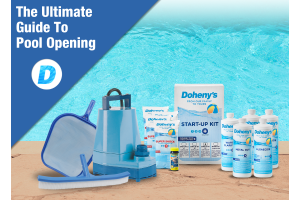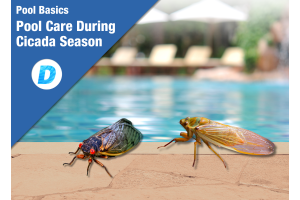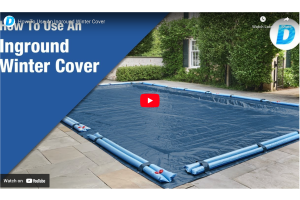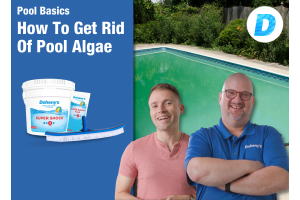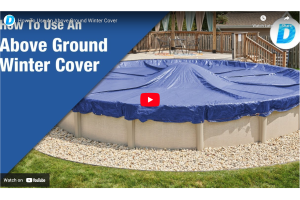The Complete Guide on Pool Chemistry
The Complete Guide on Pool Chemistry
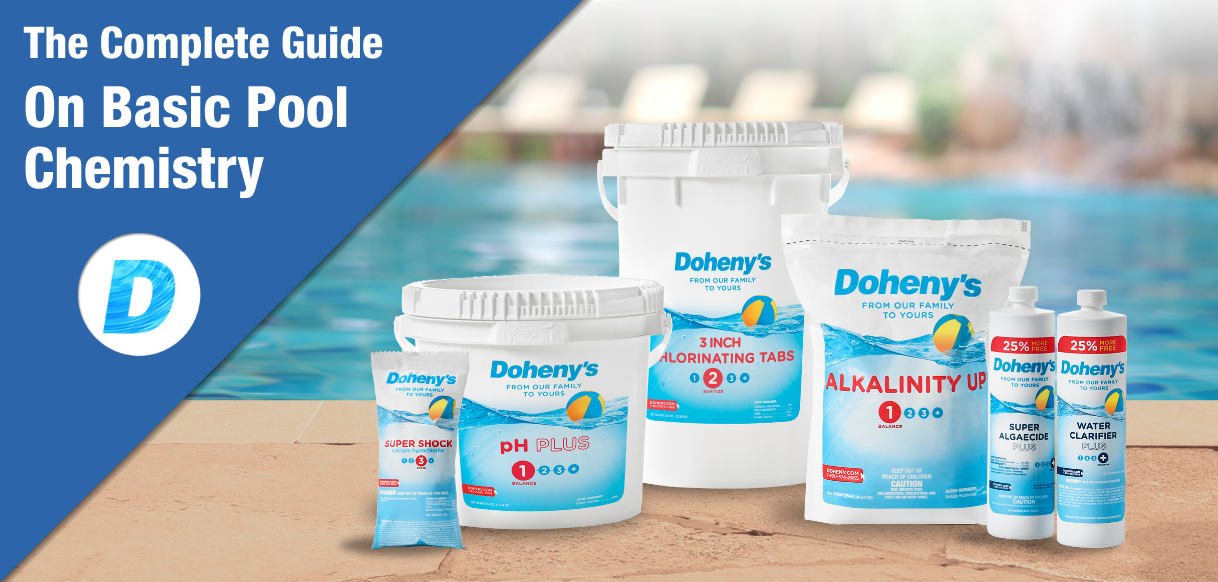

Welcome to the Doheny's ultimate guide to mastering pool chemistry. Maintaining the right pool chemistry is critical for a healthy, enjoyable pool experience. Pool chemistry relates to the balance of chemical levels in your pool's water, which directly influences water quality, safety, and clarity.
Unbalanced pool chemistry can lead to a host of issues including cloudy or discolored water, discomfort for swimmers, and potential damage to your pool equipment. High chlorine levels can cause skin and eye irritation, while low levels may lead to bacteria and algae growth. An imbalance in chemicals may also affect the efficiency of sanitizers, making them less effective in keeping your pool clean and safe. By consistently testing and balancing your pool's chemical levels, you can avoid major issues and enjoy more swim time. In this guide, we will delve into fundamental aspects of pool chemistry, covering essentials such as pool sanitizers, balancers, the role of pool shock, testing, and more.
Testing Your Pool Water
You’ll need to regularly test your pool water in order to maintain a clean and balanced swimming environment. You can use either test kits or test strips to test your pool water. Test kits include various reagents and testing solutions, while test strips provide instant results. If using test kits, make sure to check the expiration date since reagents typically last up to 1-2 years. To learn more about testing, check out our Pool Water Testing Guide blog. Now let’s get into chemicals!
Sanitizers: A Must-Have for Every Pool Owner
Pool sanitizers are one of the basic necessities for maintaining a clean and healthy swimming pool. They keep water free of bacteria and inhibit the growth of viruses, algae, and organic contaminants. If you want to keep your pool water clean and safe, you need to sanitize the water regularly!
Chlorine is one of the most widely used and effective sanitizers. It works by killing harmful bacteria, viruses, and algae in pool water. The most popular type of chlorine for everyday pool use is Trichloro-S-Triazinetrione, otherwise known as TriChlor. TriChlor is stabilized because it contains cyanuric acid, which functions like sunscreen to slow down chlorine burnoff. Doheny's sells TriChlor in sticks or tabs. You can add either option to your pool through an automated or floating chlorinator. DiChlor is another option. While it is less common, some people find it easier to use since it comes in granular form and can be added directly to pool water by hand. Doheny’s recommends sanitizing with our 99% active ingredient Doheny’s 3” Chlorinating Tabs. For some money saving tips, check out our blog on conserving chlorine.
- Optimal Chlorine Levels - Between 1.0-3.0 ppm (parts per million).
Why should you choose our chlorine? Check out our article on why Doheny’s chlorine is the best for your pool to learn more.
Another popular pool sanitizer is bromine. Particularly effective in hot tubs and spas, bromine provides sanitization even at higher temperatures and is less likely to cause eye and skin irritation, making it a preferred choice for those with sensitive skin.
- Optimal Bromine Levels - 3.0-5.0 ppm
Still deciding between the two? Check out our blog on bromine vs. chlorine to learn more!
Pool Balancers: Pillars of Proper Pool Chemistry
Balancers, as the name implies, are used to keep your pool water chemistry in balance. Imbalanced water can cause skin irritation, pool stains, and can even harm your equipment. To prevent such costly and inconvenient issues, make sure to test your pool water once a week.
Alkalinity measures your pool water's pH stability. You'll want to address any issues with the alkalinity before adjusting your pH levels, else you run the risk of pH levels bouncing right back to where they were. If you are finding that your alkalinity is too high, you can use products such as Doheny’s pH Minus to correct it, and if it’s too low, use Doheny’s Alkalinity Up to increase it.
- Optimal Alkalinity Levels - Between 80-120 ppm
pH measures how acidic or alkaline the water is. If it is too high or too low, it can cause swimmer irritation and damage to your pool or equipment. If you discover that your pH is off, you can either use Doheny’s pH Minus to reduce levels or use Doheny’s pH Plus to raise them. Once your pH is balanced, you can move on to a pool stabilizer.
- Optimal pH Levels - Between 7.2-7.6 ppm
Pool stabilizers, otherwise known as cyanuric acid (CYA), help stabilize the chlorine levels in your pool. Many pool owners don't realize that chlorine is vulnerable to heat and sunlight. In fact, chlorine evaporates rapidly when exposed to UV rays. Without the proper amount of CYA, chlorine can be reduced by as much as 95% within just 2 hours. In order to keep your chlorine effective and efficient, you’ll want to maintain CYA levels between 40-60 parts per million.
- Optimal CYA Levels - Between 40-60 ppm
Calcium hardness is the measure used to determine the amount of dissolved calcium and magnesium in your swimming pool, AKA the hardness or softness of your water. For pools topped off with well water, it’s even more important to keep an eye on calcium hardness, as well water tends to have higher levels of these chemicals.
If your calcium hardness drops below 150 parts per million, the water can become corrosive and will eat away at your pool and pool equipment. If a pool has a calcium hardness level that is over 400 parts per million, you'll begin to notice the development of cloudy water that can cause scaling.
- Optimal Hardness Level (Plaster Pools) - 225-300 ppm
- Optimal Hardness Level (Vinyl, Painted, & Fiberglass Pools) - 175-250 ppm
If you're looking to treat hard water in your pool, check out Doheny’s Calcium Hardness Reducer. This product is great for reducing the level of calcium in your pool, bringing your water quality down to optimal levels and helping keep your pool chemistry in balance.
Pool Shock: An Essential Part of Pool Maintenance
Pool shock cleans your pool and removes the byproduct left by chlorine as it breaks down. Regular shock treatments play a vital role in maintaining proper pool chemistry.
When chlorine breaks down, it forms tiny particles called chloramines. These chloramines can irritate the skin and eyes, create a strong odor, and prevent chlorine from working properly. Pool shock attacks these inactive particles and breaks them apart, helping to maintain the efficiency of your chlorine.
Di-chlor and super shock contains chlorine and is typically used to raise chlorine levels quickly, eliminating contaminants. It is recommended to use chlorinated shock weekly or after heavy pool usage. After using this shock, swimmers will need to wait 12 hours before returning to swim.
If you don’t need to sanitize your pool and just want to remove extra chloramines, you can use oxidizing shock. Since oxidizing shock doesn’t contain chlorine, your pool water will be swim-ready in just 15 minutes after use. Whichever shock you decide to use, we recommend you shock your pool once a week.
Learn more about the different types of pool shock and when to use them on our guide to shock a pool.
Algaecides vs. Algae Preventers
Controlling the growth of algae is a necessary aspect of maintaining clear pool water. Algaecides are used to kill algae, while algae preventers help to inhibit algae growth before it starts. Getting rid of any sort of algae growth can be difficult. If it goes untreated, it can cause your water to become cloudy or discolored.
Over time, the algae can worsen to the point that it causes skin irritation and damage to your pool or equipment. Our algaecides and algae preventers are effective against all common types of algae and they won’t foam or cloud your swimming pool.
In order to remove algae, use algaecides such as Doheny’s Super Algaecide Plus or Doheny’s Total Algaecide.
In order to prevent algae, use algae preventers such as Doheny’s Algaecide 60 or Doheny’s Algaecide.
Want to learn more about the different types of algae and how to remove it? Check out our blog on getting rid of pool algae.
Keeping Your Pool Water Clear
Water clarifiers improve water clarity to keep your water sparkling. A common cause of pool cloudiness is particles in the water that are too tiny for filters to grab. Water clarifiers are able to bind these tiny particles together so that they’re large enough to be trapped by the filter. We recommend Doheny’s Water Clarifier Plus, our non-foaming and non-staining formula that works quickly to clear out the tiny particles and help your pool sparkle.
Enzymes are the all-natural way to clean up the body oil and lotion that can cloud your pool water and leave a ring of scum around your pool. Adding enzymes to your pool water once a week prevents oil and scum build-up, reducing the need for harsh chemical treatments and promoting a healthier pool environment. Enzymes also linger in the filter, keeping it clean.
Metal reducers do exactly what the name suggests, reduce the levels of metal in your pool water. All pool water contains trace amounts of metals such as copper and iron. At normal levels, these metals are harmless. Even at higher levels, while they may be non-toxic, they can cause staining, scaling, and discoloration of your pool. If you have elevated levels of metal in your pool, use Doheny’s Extra-Strength Metal Out to bring those levels down and prevent unsightly stains.
In conclusion, maintaining proper pool chemistry is essential for the overall health and enjoyment of your pool. At Doheny, we offer a wide range of high-quality pool chemicals and testing supplies to help you keep your pool water crystal clear and safe for swimming.


